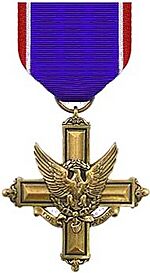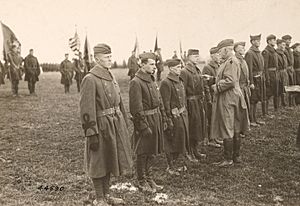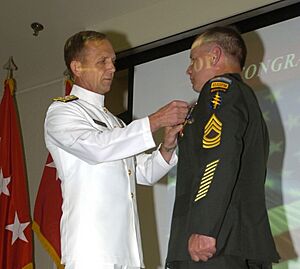Distinguished Service Cross (United States) facts for kids
Quick facts for kids Distinguished Service Cross |
|
|---|---|
 |
|
| Presented by | United States Department of the Army |
The Distinguished Service Cross (DSC) is the second highest military award given by the United States Army. It is for soldiers who show amazing bravery in battle against an enemy. To earn the DSC, a soldier's actions must be incredibly heroic. They must be more than what's needed for other U.S. combat awards. However, they should not quite meet the standards for the Medal of Honor, which is the highest award.
The Army's Distinguished Service Cross is similar to other awards. These include the Navy Cross for the Navy, the Air Force Cross for the Air and Space Forces, and the Coast Guard Cross. Before 1960, when the Air Force Cross was created, airmen also received the Distinguished Service Cross.
The Distinguished Service Cross was first given out during World War I. Some awards were even given for brave actions that happened before World War I. For example, some soldiers who had received a "Certificate of Merit" for bravery were later given the DSC. This certificate was once the only other award for bravery the Army could give. Other DSCs were given later for actions in the Philippine–American War, the Boxer Rebellion, and the Pancho Villa Expedition.
The Distinguished Service Cross is different from the Distinguished Service Medal. The Distinguished Service Medal is for excellent service to the government in important jobs. The Distinguished Service Cross, however, is only for bravery in combat.
Contents
What the Medal Looks Like
The Distinguished Service Cross is a bronze cross. It is about 2 inches (5 cm) tall and 1 and 13/16 inches (4.6 cm) wide. In the middle, it has an eagle. Below the eagle, there is a scroll that says "FOR VALOR". On the back of the cross, there is a wreath around the center. This space is used to engrave the name of the soldier who receives it.
The Ribbon's Colors
The ribbon for the medal is about 1 and 3/8 inches (35 mm) wide. It has these stripes:
- A red stripe at each edge.
- A thin white stripe next to each red stripe.
- A wide blue stripe in the middle.
Who Can Earn It?
The Distinguished Service Cross is given to a person serving with the Army. This also includes those in the Air Force before 1960. They must show amazing heroism that is just below the level for a Medal of Honor. This bravery must happen while fighting an enemy of the United States. It can also be during military operations with another country's forces. The heroic act must be so special and involve such great risk that it makes the person stand out.
How the Medal is Given
When a soldier earns more than one Distinguished Service Cross, it is shown with oak leaf clusters. These are small bronze or silver oak leaves attached to the medal's ribbon.
History of the Award
President Woodrow Wilson officially created the Distinguished Service Cross on January 2, 1918. General John J. Pershing, who led the American forces in France, had suggested this new award. He wanted a way to recognize bravery that was similar to what European armies offered. The idea was approved by Congress on July 9, 1918.
The first design of the medal was made by Captain Aymar Embury II and Lieutenant J. Andre Smith. The first medals were made by the United States Mint. Later, some small changes were made to the design to make it look even better.
The Distinguished Service Cross is the second highest U.S. military award. Only the Medal of Honor is higher. Rules for who gets the award and how it is given are found in Army regulations. Soldiers who receive the DSC and serve for more than 20 years can get a small increase in their retirement pay.
Awarding History by Conflict
World War I Heroes

During World War I, over 6,300 Distinguished Service Crosses were awarded. Some soldiers received the award more than once. The very first awards were given on March 18, 1918, to three soldiers from the 1st Infantry Division.
A few soldiers, especially pilots, earned three or more DSCs. Captain Eddie Rickenbacker, a top U.S. pilot, received a record eight DSCs. One of these was later changed to a Medal of Honor. Other famous pilots like Captain Douglas Campbell and First Lieutenant Frank O'Driscoll Hunter each received five DSCs.
Colonel John H. Parker was the only ground soldier in World War I to receive four DSCs. Many other brave soldiers, including some who had already earned the Medal of Honor, also received the DSC.
Between the World Wars
After World War I, about 62 DSCs were given for actions in Russia. Also, about 132 awards were given for brave actions in earlier wars. These included the Indian Wars, the Spanish–American War, and the Boxer Rebellion.
Famous recipients from this time include General J. Franklin Bell and General Peyton C. March, both former Army Chiefs of Staff. General of the Armies John J. Pershing also received a DSC in 1941 for bravery in the Philippine Insurrection.
World War II Heroes
During World War II, over 5,000 DSCs were awarded. Lieutenant Colonel John C. Meyer, Major General James A. Van Fleet, and Master Sergeant Llewellyn Chilson each received three DSCs. Jeannette Guyot and Virginia Hall were the only two women to receive the award.
Many soldiers who had earned a DSC in World War I received another in World War II. For example, George S. Patton Jr. received his second DSC as commander of the Seventh Army.
Over fifty soldiers received two DSCs in World War II. These included Creighton W. Abrams Jr., who later became the Chief of Staff of the Army. Six men from the 82nd Airborne Division also received two DSCs.
Twelve soldiers, three airmen, and two sailors received both the Medal of Honor and the Distinguished Service Cross in World War II. These included famous names like Douglas MacArthur and Audie Murphy.
General Paul W. Tibbets, who piloted the Enola Gay to drop the first nuclear bomb, also received the Distinguished Service Cross.
Korean War Heroes
In the Korean War, over 800 DSCs were awarded. More than 300 of these were given after the soldier had died.
Lloyd L. "Scooter" Burke, Benjamin F. Wilson, Lewis Millett, and Air Force pilot George A. Davis Jr. each earned both the Medal of Honor and the Distinguished Service Cross in Korea.
Colonel Arthur S. Champeny received his third DSC in Korea, making him the only person to receive the DSC in three different wars (World War I, World War II, and Korea).
Ten World War II recipients received a second DSC in Korea. Among them were Hobart R. Gay and Walton Walker, both commanding generals.
Vietnam War Heroes
There were over 1,000 awards in the Vietnam War. Almost 400 of these were given after the soldier had died.
Patrick Brady and Robert L. Howard received both the Medal of Honor and the Distinguished Service Cross in Vietnam. Major General Keith L. Ware, who had earned the Medal of Honor in World War II, received a DSC after he was killed in action.
James F. Hollingsworth and Thomas Tackaberry each received three DSCs, one in Korea and two in Vietnam. Both later became lieutenant generals.
Many other notable soldiers received the DSC in Vietnam. These included John W. Vessey Jr., who later became Chairman of the Joint Chiefs of Staff. Frederick C. Weyand and Bernard W. Rogers both served as Chief of Staff of the Army. Alexander M. Haig Jr. became Secretary of State.
Four members of the 1st Cavalry Division received DSCs for their bravery in the Battle of Ia Drang Valley in November 1965. Their actions were shown in the 2002 movie We Were Soldiers. One of them, Major Bruce Crandall, later had his DSC upgraded to the Medal of Honor.
Recent Awards (1975 to Present)
Since the Vietnam War, the Distinguished Service Cross has continued to be awarded. As of December 2018, it has been awarded 16 times for actions during Operation Enduring Freedom – Afghanistan. As of March 2013, it has been awarded 13 times for actions during Operation Iraqi Freedom.
Brave Actions in Afghanistan
Major Mark E. Mitchell earned the DSC for leading his team to free an American captive in Afghanistan in November 2001. Master Sergeant Brendan W. O'Connor received the DSC in June 2006. He took off his body armor to help wounded teammates while under enemy fire.
Brave Actions in Iraq
Colonel James H. Coffman Jr. received the DSC for defending a police station in Mosul, Iraq, from an attack in November 2004.
Notable Recipients
Many brave individuals have received the Distinguished Service Cross. Here are some of them:
| Name | Service | Rank | Repeat DSC | Notes |
|---|---|---|---|---|
| Creighton W. Abrams Jr. | US Army | GEN | with one Oak Leaf Cluster | Army Chief of Staff |
| Edward Almond | US Army | LTG | with one Oak Leaf Cluster | Led divisions and corps in World War II and Korea. |
| Vernon Baker | US Army | 1LT | Award later upgraded to the Medal of Honor | |
| Robert H. Barrow | US Marine Corps | General | Commandant of the US Marine Corps. | |
| Thomas Blamey | Australian Army | General | Later Australia's first Field Marshal | |
| Richard Bong | US Army Air Forces | MAJ | Medal of Honor recipient with 40 confirmed aerial victories. | |
| Maurice Britt | US Army | CPT | Also a Medal of Honor and Silver Star recipient. | |
| John D. Bulkeley | US Navy | VADM | Also Medal of Honor and Navy Cross recipient. | |
| Douglas Campbell | US Army Air Service | with four Oak Leaf Clusters | World War I flying ace. | |
| Richard Cavazos | US Army | GEN | with one Oak Leaf Cluster | First Hispanic full general. |
| Arthur S. Champeny | US Army | with two Oak leaf Clusters | Only person to receive the DSC in three different conflicts: WWI, WWII, and Korean War. | |
| Mark W. Clark | US Army | GEN | Commander of 5th Army Group. | |
| William O. Darby | US Army | with one Oak Leaf Cluster | ||
| Daniel Daly | US Marine Corps | Also Medal of Honor recipient. | ||
| Dwight F. Davis | US Army | Served as Secretary of War. | ||
| Samuel David Dealey | US Navy | Commander | Medal of Honor and four-time Navy Cross recipient. | |
| William J. "Wild Bill" Donovan | US Army | MG | Director of the Office of Strategic Services (OSS). | |
| Robert L. Eichelberger | US Army | GEN | with one Oak Leaf Cluster | Led I Corps and the Eighth Army in World War II. |
| Sam Ervin | US Army | PVT | Later a United States Senator. | |
| James M. Gavin | US Army | LTG | with one Oak Leaf Cluster | |
| Alexander Haig | US Army | GEN | Later US Secretary of State. | |
| Virginia Hall | OSS | civilian | ||
| John L. Hines | US Army | GEN | Later Army Chief of Staff. | |
| Courtney Hodges | US Army | GEN | Commanded First Army in World War II. | |
| Robert L. Howard | US Army | COL | Medal of Honor and Silver Star recipient. | |
| Frank O'Driscoll "Monk" Hunter | US Army Air Service | MG | four Oak Leaf Clusters | World War I flying ace. |
| Henry Johnson | US Army | SGT | Later upgraded to Medal of Honor, African American soldier in WWI. | |
| Robert C. Kingston | US Army | GEN | Combat Veteran of Korea and Vietnam. | |
| Curtis LeMay | US Army Air Forces | GEN | Later Air Force Chief of Staff. | |
| Douglas MacArthur | US Army | GA | with two Oak Leaf Clusters | Also received Medal of Honor and other awards. |
| Peyton C. March | US Army | GEN | Later Army Chief of Staff. | |
| Anthony McAuliffe | US Army | GEN | Led defense of Bastogne. | |
| Barry McCaffrey | US Army | GEN | with one Oak Leaf Cluster | |
| James Megellas | US Army | LTC | Considered one of the most decorated combat officers in the history of the 82nd Airborne Division. | |
| Billy Mitchell | US Army Air Service | BG | ||
| Kenneth Muir | British Army | Major | Also British Victoria Cross recipient. | |
| Audie Murphy | US Army | MAJ | Medal of Honor recipient. | |
| John "Gatling Gun" Parker | US Army | BG | with three Oak Leaf Clusters | |
| George S. Patton | US Army | GEN | with one Oak Leaf Cluster | Legendary general. |
| George Patton IV | US Army | MG | with one Oak Leaf Cluster | Son of George S. Patton. |
| John J. Pershing | US Army | GAS | Commander of the American Expeditionary Force and Army Chief of Staff. | |
| Chesty Puller | US Marine Corps | LtGen | Five-time Navy Cross recipient. | |
| Eddie Rickenbacker | US Army Air Service | CPT | with six Oak Leaf Clusters | A seventh Oak Leaf was later upgraded to the Medal of Honor. |
| Matthew B. Ridgway | US Army | GEN | with one Oak Leaf Cluster | Later Army Chief of Staff and NATO Supreme Allied Commander. |
| Bernard W. Rogers | US Army | GEN | Later US Army Chief of Staff and NATO Supreme Allied Commander. | |
| Theodore Roosevelt Jr. | US Army | BG | Also Medal of Honor recipient. | |
| Joseph Stilwell | US Army | GEN | Commander of the China Burma India Theater. | |
| Maxwell D. Taylor | US Army | GEN | Later Army Chief of Staff. | |
| James A. Van Fleet | US Army | GEN | with two Oak Leaf Clusters | Commanded Eighth Army in Korea. |
| Walton Walker | US Army | GEN | with one Oak Leaf Cluster | Died in Korea. |
| Richard Winters | US Army | MAJ | Famous from "Band of Brothers". | |
| Alvin York | US Army | MAJ | Award later upgraded to the Medal of Honor. |
When Awards Are Changed or Taken Back
Sometimes, a Distinguished Service Cross award is later changed or taken back. This usually happens for a few reasons:
- The award was upgraded to the Medal of Honor.
- The soldier received two awards for the exact same brave action by mistake.
- The award was reissued with a new, updated description.
One famous example is Alvin York from World War I. He first received a DSC, which was later upgraded to the Medal of Honor. Also, Eddie Rickenbacker, a top pilot, originally received eight DSCs, but one was upgraded to the Medal of Honor in 1930. In 1981, Master Sergeant Roy P. Benavidez had his Vietnam-era DSC upgraded to the Medal of Honor.
The Army and Congress have reviewed awards over the years. For example, in the 1990s, the Army looked into awards for black soldiers in World War II. This led to six DSCs being upgraded to the Medal of Honor in 1997. These included awards for Vernon Baker and George Watson. In 2001, 21 DSCs for Asian-American soldiers were upgraded to the Medal of Honor. This included U.S. Senator Daniel Inouye.
Bruce P. Crandall, a Vietnam War helicopter pilot, had his DSC upgraded to the Medal of Honor in February 2007. There is also a petition to upgrade the DSC of Major Richard Winters to a Medal of Honor.
See also
 In Spanish: Cruz por Servicio Distinguido (Estados Unidos) para niños
In Spanish: Cruz por Servicio Distinguido (Estados Unidos) para niños
- Awards and decorations of the United States Army


